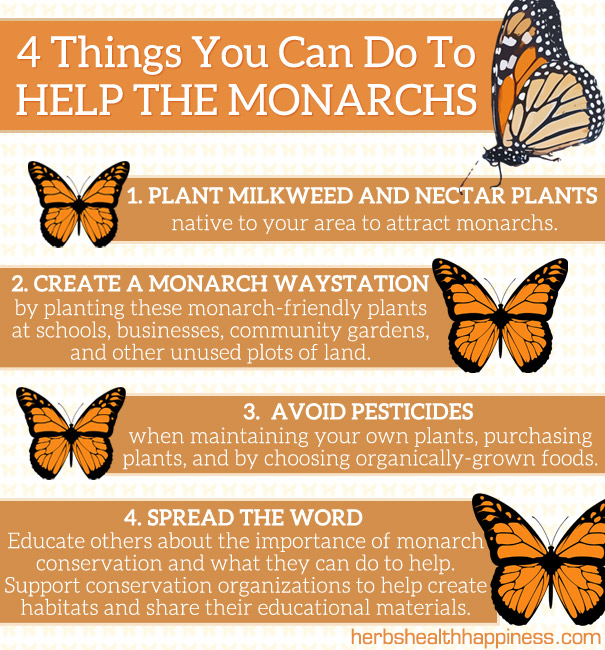Please follow us on Telegram to be sure to receive our latest posts!

Graphic © herbshealthhappiness.com
Monarch butterflies have experienced heavy population losses through a combination of causes. Here are some simple things that you can do.
1. Plant Milkweed (And Other “Butterfly Plants”): To ensure the population viability of monarchs, the best management approach is to restore the natural habitat and improving the already present habitat. The eastern North American migratory population of monarchs has decreased due to the decline in the host plants of milkweed. [1] In addition to native host milkweed plants for monarchs, it is important to plant nectar-rich plants for adult monarchs as they are dependent on nectar plants for spring food, summer breeding, and fall migrations.
2. Create a Monarch waystation: Monarch waystations can provide habitat to migrating monarch butterflies including food, shelter, and water. Using the public lands and even general public places for growing milkweed plants, nectar plants and locally adapted seeds combined with backyard gardens can create critical habitat for monarchs. [2]
3. Avoid Pesticides: Super important of course. The science is, as they say, settled: Monarch butterflies are going through a long-term population decline due to multiple factors including exposure to pesticides. Host milkweed plants are exposed to non-target pesticides as they often grow near the agricultural fields. The science is challenging because the amounts that affect the insect populations are miniscule, measured in nanograms. A study has found that monarch caterpillars consume a diversity of pesticides in their diet, with 14 pesticides detected on milkweed plants. [3] Pesticide exposure can be avoided by isolating the milkweed patches away from cropland.
4. Spread the Word: “Educate others about the importance of monarch conservation and what they can do to help.
Support conservation organizations to help create habitats and share their educational materials.” Monarch butterflies can be helped by studying, sharing information, educating and giving awareness to the people regarding their importance to the environment. Nature-based special interest groups can encourage people to take action in support of the conservation of monarch butterflies. [4]
Learn More:
References:
[1] Knight, S.M., et al., Strategic mowing of roadside milkweeds increases monarch butterfly oviposition. Global Ecology and Conservation, 2019. 19: p. e00678. https://www.sciencedirect.com/science/article/pii/S2351989419301271
[2] Landis, T.D., Monarch waystations: propagating native plants to create travel corridors for migrating monarch butterflies. Native Plants Journal, 2014. 15(1): p. 5-16. https://npj.uwpress.org/content/15/1/5.short
[3] Olaya Arenas, P.A., PESTICIDE EXPOSURE RISK AND DEVELOPMENTAL CONSEQUENCES FOR MONARCH BUTTERFLIES IN AGRICULTURAL LANDSCAPES. 2019, Purdue University Graduate School. https://hammer.figshare.com/articles/thesis/PESTICIDE…/
[4] Lewandowski, E.J. and K.S. Oberhauser, Butterfly citizen scientists in the United States increase their engagement in conservation. Biological Conservation, 2017. 208: p. 106-112. https://www.sciencedirect.com/science/article/abs/pii/S0006320715300367
😳 What Tinnitus Does To Your Brain Cells (And How To Stop It)
After 47 years of studies and countless brain scans done on more than 2,400 tinnitus patients, scientists at the MIT Institute found that in a shocking 96% of cases, tinnitus was actually shrinking their brain cells.
As it turns out, tinnitus and brain health are strongly linked.
Even more interesting: The reason why top army officials are not deaf after decades of hearing machine guns, bombs going off and helicopter noises…
Is because they are using something called "the wire method", a simple protocol inspired by a classified surgery on deaf people from the 1950s...
★ How To Get Rid Of Nail Fungus:
★ Does Your Salad Contain This Vegetable?
★ 20 Natural Painkillers In Your Kitchen (Video):
★ Men's Prostate Health:

2. Famous Chef Sheds 60lbs Researching New Paleo Recipes: Get The Cookbook FREE Here
3. #1 muscle that eliminates joint and back pain, anxiety and looking fat
4. 7 odd foods that KILL your abdominal fat (surprising fat-fighters)
5. The TRUTH about bread (Will surprise you!)
6. [PROOF] Reverse Diabetes with a "Pancreas Jumpstart"
7. Here's What Happens When You "Unlock Your Hip Flexors"
8. The #1 WORST food that CAUSES Faster Aging (beware -- Are you eating this?)
The #1 Muscle That Eliminates Joint And Back Pain, Anxiety And Looking Fat
By Mike Westerdal CPT
Can you guess which muscle in your body is the #1 muscle that eliminates joint and back pain, anxiety and looking fat?
This is especially important if you spend a significant amount of time sitting every day (I do, and this really affects me in a big way!)
Working this "hidden survival muscle" that most people are simply not training because no-one ever taught them how will boost your body shape, energy levels, immune system, sexual function, strength and athletic performance when unlocked.
If this "hidden" most powerful primal muscle is healthy, we are healthy.
Is it...
a) Abs
b) Chest
c) Glutes
d) Hip Flexors
Take the quiz above and see if you got the correct answer!
P.S. Make sure you check out this page to get to know the 10 simple moves that will bring vitality back into your life:
If you enjoyed this page:












